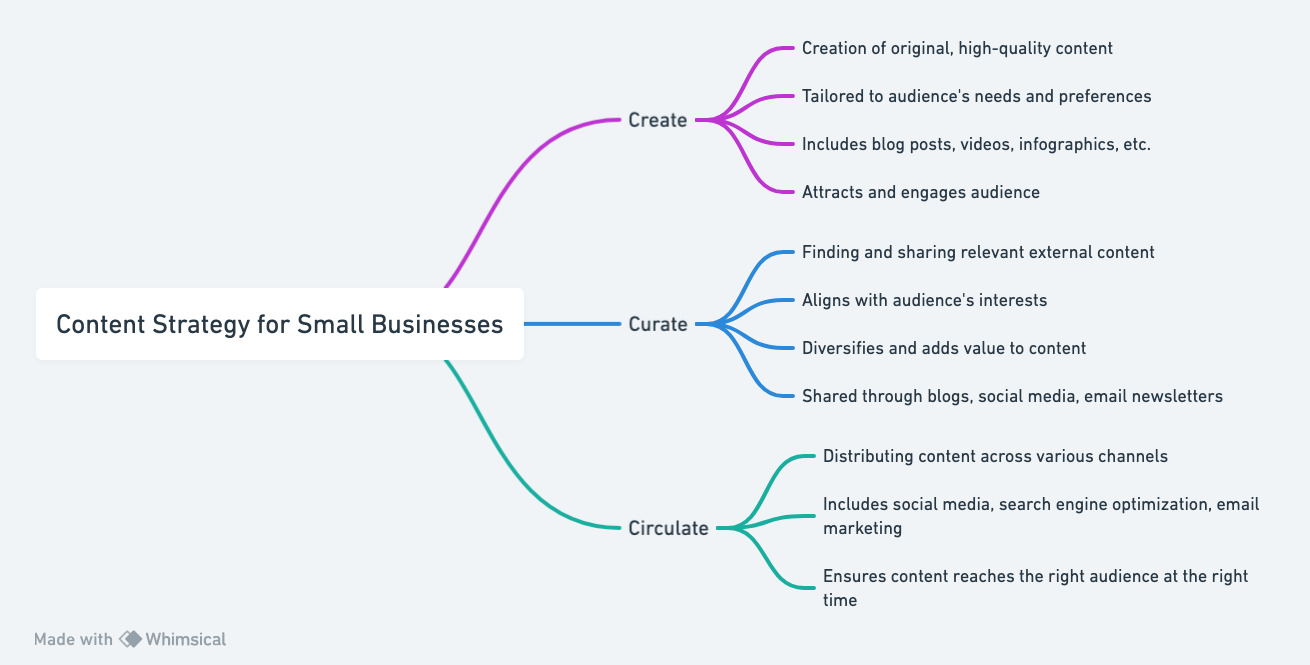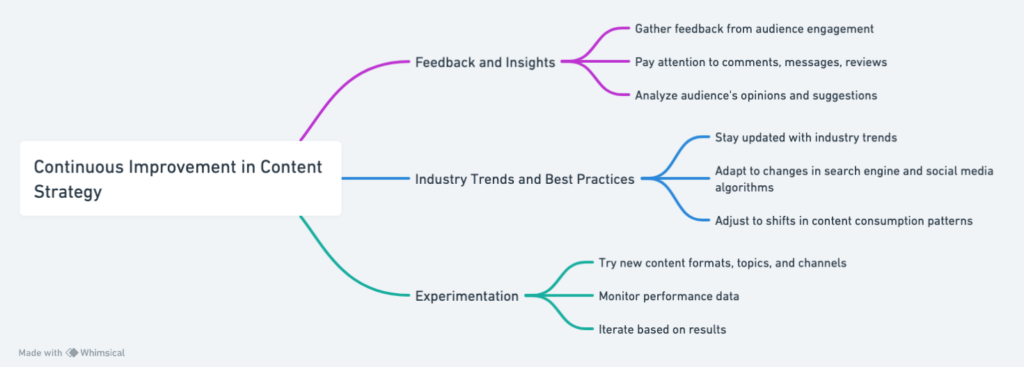Small businesses must have a good content marketing plan to stand out and reach their audience.
This guide will show you how to create a content strategy that gets results for small businesses.
Implementing a content strategy offers several benefits for small businesses long term.
-
To start, it establishes the business as a thought leader, which gives it brand authority and credibility.
-
A content strategy helps businesses connect with customers, building relationships and brand loyalty.
-
A good content marketing strategy can help small businesses get leads and make sales.
This article has multiple parts. It helps small businesses make a content strategy.
We will start with Part 1. We will learn the basics of content strategy.
This includes what content marketing is, the three C’s of content strategy, and the role of the audience.
Part 1: Understanding the Basics of Content Strategy
1.1 What is Content Marketing?
Content marketing can be defined as a strategic approach to creating and distributing valuable, relevant, and consistent content to attract and retain a clearly defined audience.
Unlike traditional marketing, which focuses on directly promoting products or services, content marketing aims to provide valuable information and resources to the audience.
Content marketing is especially important for small businesses because it allows them to showcase their expertise and build trust with potential customers.
By creating helpful and educational content, small businesses can establish themselves as industry authorities and gain the attention and loyalty of their target audience.
1.2 The Three C’s of Content Strategy
The three C’s of content strategy – Create, Curate, and Circulate – are the key pillars of a successful content marketing strategy.

- Create: This involves the creation of original and high-quality content that is tailored to the target audience’s needs and preferences. This can include blog posts, videos, infographics, and more. By creating valuable content, small businesses can attract and engage their audience.
- Curate: Curating content involves finding and sharing relevant content from external sources that align with the target audience’s interests. This helps to diversify the content and provide additional value to the audience. Curated content can be shared through blog articles, social media posts, or email newsletters.
- Circulate: Once the content is created and curated, it is important to circulate it through various channels to reach the target audience. This can include sharing content on social media platforms, optimizing it for search engines, and promoting it through email marketing campaigns. Circulating content effectively ensures that it reaches the right people at the right time.
If you need help generating great content Check our effective content creation tips page.
1.3 The Role of Target Audience
The target audience plays a crucial role in content strategy.
It is important for small businesses to identify and understand their audience in order to create content that resonates with them.
Defining the target audience involves identifying key attributes such as demographics, interests, and pain points.
Small businesses can conduct market research, analyze customer data, and gather insights to develop a comprehensive understanding of their audience.
By understanding the target audience, small businesses can create content that addresses their needs and interests. This not only helps to capture the audience’s attention but also builds trust and credibility.
Creating content that resonates with the target audience is the key to a successful content strategy.
Part 2: How To Create A Small Business Content Strategy
2.1 Step 1: Set Clear Goals and Objectives
Setting clear goals and objectives is a crucial first step in creating a content strategy.
By defining what you want to achieve with your content marketing efforts, you can align your strategy with your overall business goals.
For example,
if your goal is to increase brand awareness, you can create content that focuses on educating your audience about your products or services and sharing valuable industry insights.
If your objective is to generate sales leads, you can create content that provides solutions to common customer problems and includes strong calls to action.
To set clear goals and objectives, it’s important to make them specific, measurable, achievable, relevant, and time-bound (SMART goals).
This will help you track your progress and evaluate the success of your content marketing strategy.
For instance, instead of setting a general goal of “increase website traffic,” a more specific and measurable goal could be “increase organic website traffic by 20% within six months.”
By setting clear goals and objectives, you can stay focused and ensure that your content strategy is driving tangible results for your small business.
2.2 Step 2: Conduct Market Research
Market research plays a crucial role in creating a strategy for small businesses.
It helps you gather insights about your target audience, competitors, and industry trends, which can inform your content creation and distribution efforts. By understanding your target audience’s needs, preferences, and pain points, you can create content that resonates with them and addresses their specific challenges.
To conduct market research, you can start by analyzing your existing customer data, such as demographics, buying behavior, and feedback.
You can also use online surveys, focus groups, and interviews to gather more in-depth insights.
Additionally, you can leverage competitor analysis to understand what content they are producing and how you can differentiate yourself.
There are various tools and resources available to help you conduct market research.
Google Trends can provide valuable information about trending topics and search volume, while social media listening tools like Feedalpha and Sprout Social can help you monitor conversations and gather insights from your target audience.
By conducting thorough market research, you can ensure that your content strategy is informed by data and tailored to meet the needs of your small business’s target audience.
2.3 Step 3: Develop Buyer Personas
Buyer personas are fictional representations of your ideal customers, and they play a crucial role in shaping your content strategy.
By developing detailed buyer personas, you can create content that speaks directly to your target audience’s needs, interests, and pain points.
This helps you build stronger relationships with your audience and positions your small business as a thought leader in your industry.
To develop buyer personas, start by analyzing your existing customer data and conducting surveys or interviews with your target audience.
Look for common demographics, behaviors, and preferences among your customers. Use this information to create detailed profiles that include key attributes such as age, gender, job title, challenges, goals, and preferred content formats.
For example, if you’re targeting busy professionals, you may find that they prefer short, informative blog posts or video tutorials.
When creating buyer personas, it’s important to remember that they should be based on real data and insights.
Avoid making assumptions or stereotypes about your target audience.
By developing accurate and detailed buyer personas, you can ensure that your content is relevant, valuable, and engaging for your small business’s potential customers.
2.4 Step 4: Create a Content Calendar
A content calendar is a tool that helps you organize and plan your content creation efforts.
By creating a content calendar for your small business, you can ensure that you consistently produce high-quality content that aligns with your overall content strategy. It allows you to map out your content production schedule, plan for upcoming events or holidays, and ensure that you’re covering a variety of topics that resonate with your target audience.
When creating a content calendar, start by identifying the key themes or topics that align with your business goals and target audience’s interests.
Break these themes down into specific content ideas or titles for blog articles, videos, infographics, or social media posts.
Assign deadlines and responsibilities to team members to ensure accountability and timely delivery of content.
It’s important to maintain a consistent content schedule to keep your audience engaged and build brand loyalty.
Regularly updating your website or blog with fresh and relevant content can also improve your search engine ranking and visibility.
By creating a content calendar and sticking to it, you can ensure that your small business stands out in the saturated online marketplace and consistently delivers valuable and engaging content to your audience.
Part 3: Implementing a Content Marketing Strategy
3.1 Step 5: Content Creation and Distribution
It is essential to produce content that is informative, engaging, and relevant to your target audience.
To do this, start by conducting thorough research on the topics that resonate with your audience.
Look for trending industry news, frequently asked questions, and common pain points that your target audience experiences.
This research will help you identify the type of content that will attract and engage your audience.
Once you have your content ideas, it’s important to use different content formats to appeal to different preferences and learning styles.
Blog posts are a popular and effective format, but don’t limit yourself to just writing.
Consider creating videos, infographics, podcasts, or interactive tools to provide valuable content in different ways.
This variety will help you cater to a wider audience and keep your content fresh and engaging.
After creating your content, you need to distribute it through various channels to reach your target audience.
Social media platforms are an excellent way to promote your content and reach a wide audience. Share your content on your social media accounts and engage with your followers by responding to comments and questions.
Additionally, consider reaching out to influencers or industry experts who can help amplify your content to their followers.
Finally, don’t forget about email marketing.
Sending regular newsletters or updates to your subscribers is a great way to promote your content and keep your audience informed.
3.2 Step 6: Optimize for Search Engines
When people search for keywords related to your industry or business, you want your content to appear on the first page of results.
To optimize your content for search engines, start by conducting keyword research.
Identify the keywords and phrases that your target audience is likely to search for, and incorporate them naturally into your content.
In addition to keywords, there are several other SEO best practices to keep in mind.
One important aspect is the use of internal links within your content.
Internal links help search engines understand the structure of your website and navigate between different pages.
They also help users discover related content and spend more time on your website.
Slow-loading websites can negatively impact your search engine ranking.
Optimize your website by compressing images, minimizing code, and using caching techniques to improve loading speed.
Mobile optimization is also crucial because an increasing number of people access the internet through their mobile devices.
Ensure that your website is mobile-friendly and responsive to provide a seamless user experience.
3.3 Step 7: Promote Content on Social Media
Social media platforms offer a valuable opportunity to promote your content and build brand awareness.
With billions of active users, social media platforms provide a vast audience that you can tap into.
To effectively promote your content on social media, you need to create engaging social media posts.
Start by understanding the different social media channels and their unique features. Tailor your content to each platform to maximize engagement.
For example, Instagram is a visual platform, so focus on creating eye-catching images or videos. Twitter has character limitations, so craft concise and attention-grabbing captions.
Experiment with different types of content, such as polls, quizzes, or live videos, to keep your audience engaged and interested.
Building brand awareness and engaging with your target audience on social media requires consistency.
Regularly post relevant and valuable content to keep your audience coming back for more.
Use social media scheduling tools to plan and automate your social media posts, ensuring a consistent presence across platforms.
In conclusion, implementing a content marketing strategy involves creating high-quality content, optimizing it for search engines, and promoting it on social media platforms.
By following these steps, you can effectively reach your target audience, increase your online visibility, and drive more traffic to your website.
Part 4: Measuring Success and Continuous Improvement
4.1 Tracking and Analyzing Performance
To measure the success of your content marketing efforts, it’s crucial to track and analyze key metrics. By doing so, you can evaluate the effectiveness of your content strategy and make data-driven decisions for continuous improvement.
One important tool for tracking performance is Google Analytics.
It provides valuable insights into website traffic, user behavior, and conversion rates.
By analyzing this data, you can identify which pieces of content are performing well and which ones need improvement.
In addition to Google Analytics, social media analytics tools can also help you track the performance of your content on various social media platforms.
These tools provide valuable information such as engagement rates, reach, and follower growth.
By monitoring these metrics, you can determine which types of content resonate with your audience and adjust your content strategy accordingly.
When analyzing performance data, it’s important to look beyond the numbers. It’s not just about the quantity of views or likes, but also the quality of engagement.
Are your audience members taking further action, such as signing up for your email newsletter or making a purchase?
By understanding the impact of your content on your bottom line, you can gain a deeper understanding of its effectiveness.
4.2 Making Adjustments and Iterations
Continuous improvement is key to a successful content strategy. Based on the insights gathered from tracking and analyzing performance, it’s important to make adjustments and iterations to your content strategy.

One way to do this is by gathering feedback and insights from audience engagement.
Pay attention to comments, messages, and reviews from your audience.
What are they saying about your content?
Are there any recurring themes or suggestions for improvement?
By listening to your audience, you can gain valuable insights to refine and optimize your content.
Another strategy for continuous improvement is to stay up-to-date with industry trends and best practices.
The digital landscape is constantly evolving, and what worked yesterday might not work today.
Stay informed about changes in search engine algorithms, social media algorithms, and content consumption patterns.
By adapting your content strategy to these changes, you can stay ahead of the competition and deliver content that resonates with your audience.
Lastly, don’t be afraid to experiment and try new things.
Test different content formats, topics, and distribution channels to see what works best for your small business.
Keep an eye on the performance data and iterate based on the results.
By continuously experimenting and iterating, you can refine your content strategy and deliver even better results over time.
In conclusion, measuring the success of your content marketing efforts and continuously improving your content strategy is crucial for small businesses.
By tracking and analyzing performance, you can gain valuable insights into what works and what doesn’t.
By making adjustments and iterations based on this data, you can optimize your content strategy and deliver even better results.
Remember to listen to your audience, stay informed about industry trends, and be willing to experiment.
With a well-defined content strategy and a commitment to continuous improvement, your small business can achieve great success in content marketing.
For further learnings you can check out this video from SEMrush

